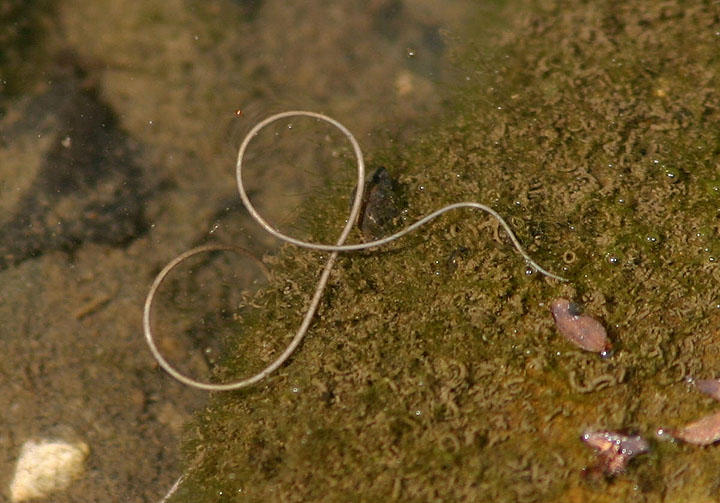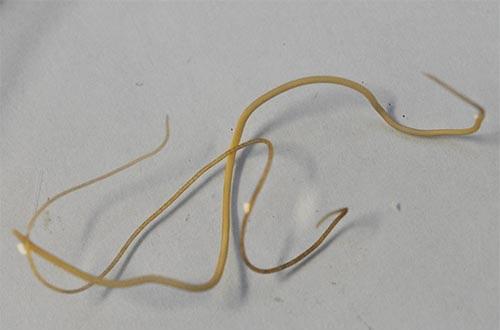
 Greenhouse, Nursery & Garden Centers Show Greenhouse, Nursery & Garden Centers submenu. New Hampshire Master Gardener Alumni Association. New Hampshire Master Gardeners Show New Hampshire Master Gardeners submenu. Yard & Garden Show Yard & Garden submenu. North Country Fruit & Vegetable Seminar & Tradeshow. Fruit & Vegetable Crops Show Fruit & Vegetable Crops submenu. Farm & Ranch Stress Assistance Network (FRSAN). Farmer Support Networks Show Farmer Support Networks submenu. Dairy, Livestock & Forage Crops Show Dairy, Livestock & Forage Crops submenu. Labor & Financial Recordkeeping & Analysis. Agricultural Business Management Show Agricultural Business Management submenu. Agriculture & Gardens Show Agriculture & Gardens submenu. Horsehair worms do not survive long in dry environments. In some situations, controlling spillage will greatly reduce the problem. Excluding insects from water containers can also help. Routinely rinse and flush water vessels to keep them clean. Horsehair worms are unable to parasitize humans. When mature, they exit the host when it is near water and the host dies. The worms complete their development inside the body of the host. Beetles, crickets, grasshoppers, centipedes, millipedes and cockroaches are common hosts. In others, the eggs hatch in the water and the tiny larvae enter the body of an arthropod (insects and their relatives) living in the water or along the water’s edge. In some species, insects become infected when they eat plants with attached eggs. The worms deposit their eggs in strings in the water, often on water plants. They are often found slowly writhing in a tangled knot (named after the Gordian knot of ancient Greek legend). In some species the rear end of the body ends in two or three lobes.
Greenhouse, Nursery & Garden Centers Show Greenhouse, Nursery & Garden Centers submenu. New Hampshire Master Gardener Alumni Association. New Hampshire Master Gardeners Show New Hampshire Master Gardeners submenu. Yard & Garden Show Yard & Garden submenu. North Country Fruit & Vegetable Seminar & Tradeshow. Fruit & Vegetable Crops Show Fruit & Vegetable Crops submenu. Farm & Ranch Stress Assistance Network (FRSAN). Farmer Support Networks Show Farmer Support Networks submenu. Dairy, Livestock & Forage Crops Show Dairy, Livestock & Forage Crops submenu. Labor & Financial Recordkeeping & Analysis. Agricultural Business Management Show Agricultural Business Management submenu. Agriculture & Gardens Show Agriculture & Gardens submenu. Horsehair worms do not survive long in dry environments. In some situations, controlling spillage will greatly reduce the problem. Excluding insects from water containers can also help. Routinely rinse and flush water vessels to keep them clean. Horsehair worms are unable to parasitize humans. When mature, they exit the host when it is near water and the host dies. The worms complete their development inside the body of the host. Beetles, crickets, grasshoppers, centipedes, millipedes and cockroaches are common hosts. In others, the eggs hatch in the water and the tiny larvae enter the body of an arthropod (insects and their relatives) living in the water or along the water’s edge. In some species, insects become infected when they eat plants with attached eggs. The worms deposit their eggs in strings in the water, often on water plants. They are often found slowly writhing in a tangled knot (named after the Gordian knot of ancient Greek legend). In some species the rear end of the body ends in two or three lobes. 
Typically they are 20 to 30 centimeters long (8-12 inches) but only 1 millimeter wide.

Unlike earthworms, their bodies are not segmented. The marine forms are in the Class Nectonematoida, while terrestrial and fresh water forms are in the Class Gordioida. These animals constitute the Phylum Nematomorpha. They do not harm people, pets, or plants. They have turned up in bird baths, water troughs, wet sidewalks, toilets, and crops in moist soil. In New Hampshire they are mostly found during the late spring and summer. Horsehair worms are very long, slender parasites of insects that are found in moist places.







 0 kommentar(er)
0 kommentar(er)
